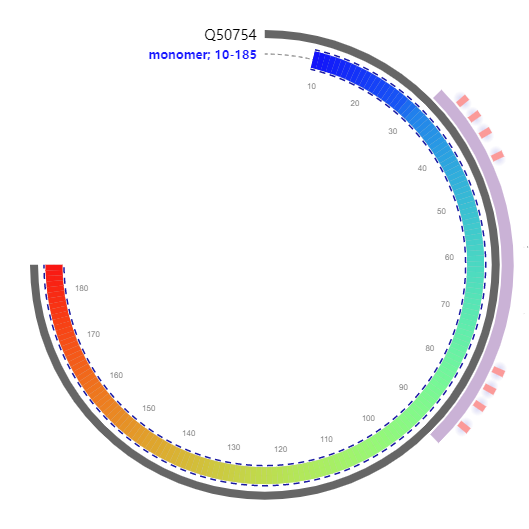Heterodisulfide reductase (Hdr), is an iron-sulfur protein which in anaerobic methanogenic archaea catalyzes the reduction of the disulphide bond between coenzyme M and coenzyme B and is coupled to methane formation
MTLLQREENIIRKGNIDKEFSEKIKAAGGDSLEYCFQCGTCTGSCPSGRRTPYRVRQIIR
KANVGLKDEIISDPTLWMCTTCYSCQERCPRKVKIVDVVKLARNEAAKAGFMAPAHKAVG
SFVIKTGHGVPINDATMELRKAVGLGELPPTTHQFPEALEEVQKIIKATGFDQLIGYNWE
TGELE
189

| PMID | Title & Author | Abstract | Year | |
| 0 | 22760247 | Expression, purification and molecular modeling of another HdrC from Acidithiobacillus ferrooxidans which binds only one [4Fe-4S] cluster .Yuandong Liu , Jiaju Ji, Runlan Yu, Guanzhou Qiu | The heterodisulfide reductase complex HdrABC from Acidithiobacillus ferrooxidans was predicted to have novel features that work in reverse to catalyse the sulfane sulfur of GSnH species (n > 1) into sulfite in sulfur oxidation. There are two different highly upregulated genes potentially encoding the HdrC subunit in A. ferrooxidans grown in sulfur-containing medium. An HdrC containing iron-sulfur cluster from A. ferrooxidans corresponding to one of the genes had been expressed and biophysically characterized. Comparatively, here we report the cloning, expression, and characterization of another HdrC from A. ferrooxidans. This HdrC was expressed in inclusion bodies in all conditions tested. This purified HdrC displayed brown color and contained the [4Fe-4S] cluster confirmed by the UV-scanning and EPR spectra. This HdrC owned two identical motifs (Cx(2)Cx(2)Cx(3)C) including total of eight cysteine residues for [4Fe-4S] cluster binding. To our surprise, the site-directed mutagenesis results of these eight residues revealed that respective removal of the sulfhydryl group of Cys73, Cys76, Cys79, and Cys37 resulted in the cluster loss, but those of Cys27, Cys30, Cys33, and Cys83 had no influence, which demonstrated that this HdrC bound only one cluster, and it might be responsible for causing the HdrABC in A. ferrooxidans working in reverse. Molecular modeling results also supported the above results and showed that this cluster was ligated by Cys73, Cys76, and Cys79 in one motif and Cys37, however, in another motif. | 2012 |
| 1 | 23053491 | HdrC2 from Acidithiobacillus ferrooxidans owns two iron-sulfur binding motifs but binds only one variable cluster between [4Fe-4S] and [3Fe-4S]. Yuandong Liu 1, Shuhui Guo, Runlan Yu, Jiaju Ji, Guanzhou Qiu | The heterodisulfide reductase complex HdrABC from Acidithiobacillus ferrooxidans was suggested to own novel features that act in reverse to convert the sulfane sulfur of GS( n )H species (n > 1) into sulfite in sulfur oxidation. The HdrC subunit is potentially encoded by two different highly upregulated genes sharing only 29 % identity in A. ferrooxidans grown in sulfur-containing medium, which were named as HdrC1 and HdrC2, respectively and had been confirmed to contain iron-sulfur cluster by expression and characterization, especially the HdrC1 which had been showed to bind only one [4Fe-4S] cluster by mutations. However, the mutations of the HdrC2 remain to be done and the detailed binding information of it is still unclear. Here, we report the expression, mutations, and molecular modeling of the HdrC2 from A. ferrooxidans. This HdrC2 had two identical motifs (Cx(2)Cx(2)Cx(3)C) containing total of eight cysteine residues potentially for iron-sulfur cluster binding. This purified HdrC2 was exhibited to contain one variable cluster converted between [4Fe-4S] and [3Fe-4S] according to different conditions by the UV-scanning and EPR spectra. The site-directed mutagenesis results of these eight residues further confirmed that the HdrC2 in reduction with Fe(2+) condition loaded only one [4Fe-4S](+) with spin S = 1/2 ligated by the residues of Cys73, Cys109, Cys112, and Cys115; the HdrC2 in natural aeration condition lost the Fe atom ligated by the residue of Cys73 and loaded only one [3Fe-4S](0) with spin S = 0; the HdrC2 in oxidation condition loaded only one [3Fe-4S](+) with spin S = 1/2. Molecular modeling results were also in line with the experiment results. | 2012 |
Ehrenfeld N , Levicán, Gloria, Parada P . Heterodisulfide Reductase from Acidithiobacilli is a Key Component Involved in Metabolism of Reduced Inorganic Sulfur Compounds[J]. Advanced Materials Research, 2013, 825:194-197.